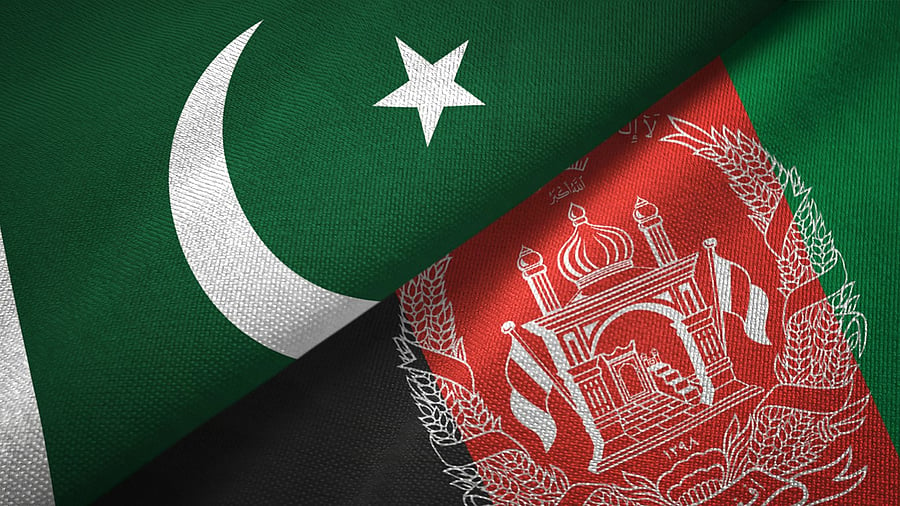
Representative image showing Pakistan and Afghanistan's national flags.
Credit: iStock Photo
Pakistan possibly holds the world record for unleashing Frankenstein’s monsters. The Afghan Taliban are one of them. Pakistan backed them during the civil war following the exit of Soviet forces from Afghanistan and, later, against the US-led NATO forces. It hailed their military victory in August 2021.
Over three years later, the relationship lies in tatters. Besides the Taliban’s refusal to accept Pakistan’s hegemony and recognise the Durand Line as the border, their reluctance to rein in the activities of the Tehreek-e-Taliban Pakistan (TTP), also known as the Pakistani Taliban, has become a major bone of contention. They characterise the TTP as Pakistan’s internal problem and counsel dialogue to resolve it.
With Pakistan losing 685 security personnel in over 400 terror attacks, many involving the TTP, 2024 has proved to be the deadliest year for its security forces in a decade. The TTP has also developed links with Baloch insurgent groups. Pakistan has so far failed to resolve the problem. The dialogue route adopted during Imran Khan’s premiership was discredited as it enabled the TTP cadres to regroup and allowed many of them to return to Pakistan’s tribal belt. Restrictions on Afghanistan’s transit trade through Pakistan have often led to protests by the Pakistani constituency that benefits from it. Pakistan expelled a large number of undocumented Afghans to build pressure on the Taliban, but to no avail. It has resorted to airstrikes on purported TTP hideouts in Afghanistan on a few occasions, the latest occurring on 24 December in Afghanistan’s eastern Paktika province.
Pakistan stated that it had carried out the operation based on accurate intelligence to target the TTP. The Taliban, on the other hand, claimed the airstrike killed close to fifty people, mainly women and children. The UN Assistance Mission in Afghanistan said it too had received credible reports of the killing of dozens of civilians, including women and children.
Significantly, the airstrike took place within hours of the meetings between Pakistan’s Special Representative, Mohammad Sadiq, and the Taliban Interior and Foreign Ministers as part of renewed dialogue. Since the Pakistan army has tight control over key foreign policy issues, it could not have been a case of the army and civilians pulling in opposite directions. Did the responses of the Interior and Foreign Ministers to Sadiq disappoint Pakistan? Even so, the timing of the airstrike was odd. Sadiq met the Taliban Deputy Prime Minister for Political Affairs, Abdul Kabir, after the strike.
The Taliban vowed to defend Afghanistan’s independence and sovereignty. Their Ministry of Defence announced that Afghan forces had carried out retaliatory strikes on targets beyond the “hypothetical line” (Durand Line). Clashes on the border continued for some time thereafter. Both sides would like to avoid an all-out conflict. Pakistan knows well that its military means cannot succeed where the mighty US-led NATO military machine failed. Pushed into a corner, the Taliban could resort to guerrilla tactics and intensify terrorism against Pakistan. The Taliban, too, are constrained by Afghanistan’s dependence on Pakistan, particularly regarding transit trade. Therefore, it was unsurprising that Abdul Kabir’s meeting with Sadiq proceeded after the airstrike to avoid a complete rupture. However, as the factors underlying the conflict remain unresolved, further flare-ups cannot be ruled out. This, together with widespread unrest in Pakistan’s tribal belt, creates an extremely volatile mix.
Asif Durrani, Pakistan’s Special Representative for Afghanistan until recently, has said that the TTP cadres are more aligned with the Haqqani faction of the Taliban and reside in the Haqqani-controlled Paktika and Khost. Referring to the Haqqani family’s business interests in Waziristan, he wonders whether they are “running with the hare and hunting with the hounds.” He points out that, ironically, the Haqqanis maintain close relations with Pakistani officials.
Amid these developments comes the news that General Asim Malik, Director General of ISI, recently met Tajik President Emomali Rahmon to discuss closer anti-terror coordination. Tajikistan has had serious security concerns regarding Taliban-controlled Afghanistan, notably because of the presence of Jamaat Ansarullah, which seeks to overthrow Rahmon’s regime. Further, the National Resistance Front of Afghanistan (NRF), composed largely of former anti-Taliban Northern Alliance cadres, is also based in Tajikistan. This has given rise to speculation about a new front developing against the Afghan Taliban.
Tajikistan has sought to address its Afghanistan-related security concerns through the Collective Security Treaty Organisation (CSTO), which includes Russia, Kazakhstan, Kyrgyzstan, and Tajikistan. The Central Asian countries other than Tajikistan seek to develop closer ties with the Taliban. Russia recently enacted a law to remove the Taliban from its blacklist. Will Rahmon break ranks with the CSTO to the point of forging an anti-Taliban alliance with Pakistan? Will the NRF leadership, hounded by Pakistanis over the years, find it possible to work with them? Developments on this front will bear careful watching, as equations in Afghanistan have shifted quickly in the past, depending on the exigencies of the situation. Any desperate attempt by Pakistan to destabilise Afghanistan again would ignore the fundamental truth that Afghans are fiercely independent, and no government in Kabul will toe its line.
India has had centuries-old links with the Afghan people, and what happens in Afghanistan affects our security. Therefore, though we have not formally recognised the Taliban government, like many other countries, we are represented in Kabul and have been providing humanitarian assistance. A senior Ministry of External Affairs official was in Afghanistan recently and met both the Taliban Foreign and Defence Ministers. According to the Taliban Foreign Ministry, the Indian diplomat spoke, inter alia, of development assistance besides humanitarian aid. The use of the Chabahar port in Iran for trade between India and Afghanistan also reportedly came up. However, India will need to remain nimble-footed to respond to any moves by Pakistan to build new linkages in the context of Afghanistan.
(The writer is a former High Commissioner to Pakistan and author of the book ‘India’s Pakistan Conundrum: Managing a Complex Relationship’.)